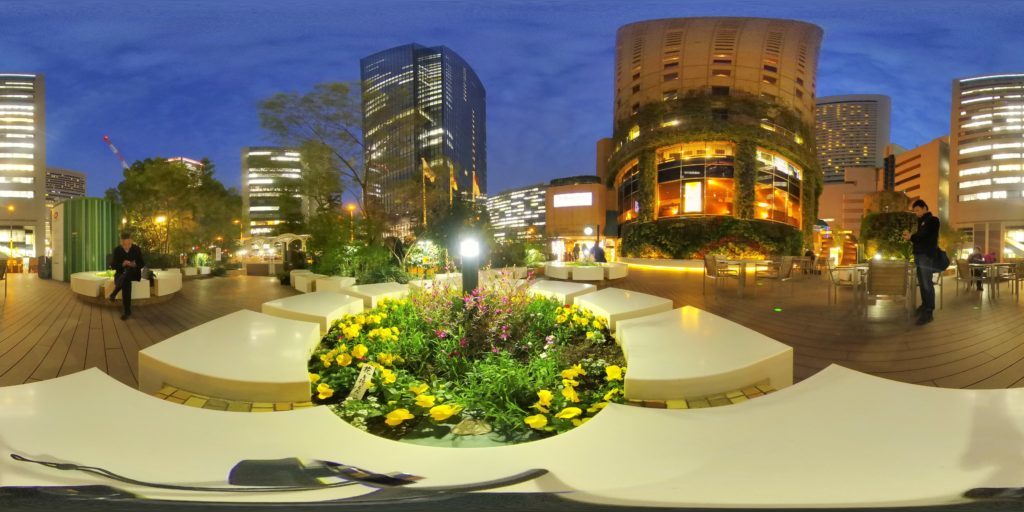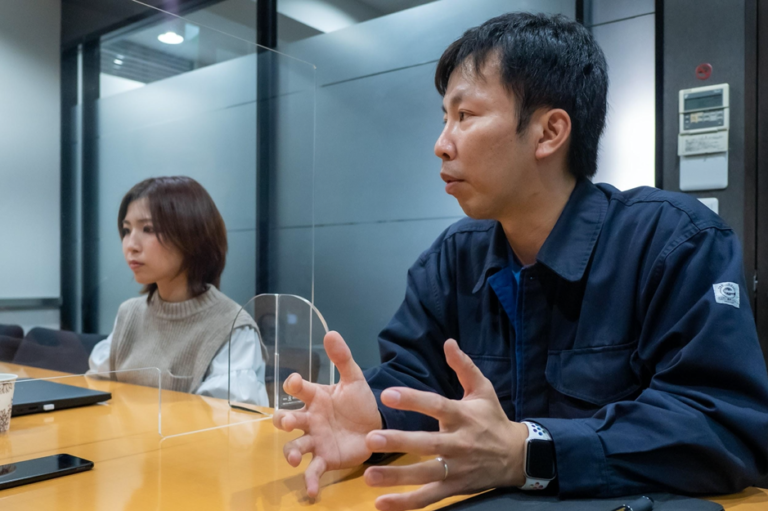THETA Z1, the flagship model sporting the highest image quality in the THETA series, has been on sale for about one year.
We interviewed Yusuke Shimizu, the THETA Z1 product manager from Ricoh Co., Ltd., about his thoughts on the Z1 and what goes into its development!
Developing THETA Z1
About 7 years have passed since the first THETA was launched in 2013, and the THETA Z1 is the sixth model in the series.
As the flagship THETA model, how did you intend to evolve the 360-degree camera concept with the THETA Z1?
I began to conceptualize the Z1 around the fall of 2015, just after the launch of THETA S. According to a questionnaire we sent out to THETA users, there were many customers who demanded high resolution and high sensitivity along with excellent image quality.

In addition, we noticed that THETA was becoming more popular with photography enthusiasts, such as DSLR owners, not only with gadget lovers.
Therefore, I wanted to create the best possible camera in regards to still image quality, one that would surely satisfy photo lovers.
Personally, it was my desire to increase the number of good 360-degree images in the world by getting more photographers to use THETA.
What was the biggest challenge for you?
Actually, the lens itself was in development before we began planning the Z1. It took considerable effort to develop the lens, but my focus was the Z1 body itself, and since the nature of the camera was clear from the beginning, I did not feel much difficulty on this project.

Of course, we wanted to include every feature we had in mind because this is our most high end model, but based on various constraints we had to make difficult decisions on what to include. It was the most challenging aspect of the project.
THETA Z1 Image Quality
The THETA Z1 pursues the highest quality still images, but what is the specific strong point in image quality?
The term “image quality” has many aspects. The Z1 has a resolution of 7K in still images (approximately 23 million pixels), but I focused on aspects of image quality that can’t be expressed by just scaling the resolution.
For example, when shooting outdoors under strong sunlight many visual defects can occur, such as red ghosting, purple fringing, and whiteout, but the Z1 significantly reduces these problems.

L: Taken with THETA V / R: Taken with THETA Z1
Also, the biggest appeal of the Z1 is that it is much better for high-sensitivity shooting due to the 1.0-inch sensor.
As a result, the Z1 allows you to take beautiful pictures with low noise even at night or in dimly lit indoor locations, which previous THETA models couldn’t do so well.

It means that the basic image quality is greatly improved in both bright outdoor and dim indoor settings, doesn’t it?
Yes, I think you can tell the differences in image quality between the Z1 and previous THETA models even if you shoot in JPEG with the AUTO setting.
Pursuing Ease of Use in THETA Z1
What did you focus on other than image quality?
Normally, you need to connect your smartphone to THETA when you change or check settings. With the Z1, I wanted ‘a few more’ operations that can be done only on the Z1 itself, rather than on a smartphone. The ‘a few more’ is key.

When adding operations to the THETA main body, we need to increase the number of buttons on the body or add other inputs such as dials. However, I assumed that there would be many existing THETA users upgrading to the Z1, so I wanted to follow the size, design, and operation of previous THETA models.
So, only one button on the body (Fn button) was added, and in addition to the newly added display panel on the body, we added ‘a few more’ operations that can be performed on the body compared to previous models.

What exactly do you mean by ‘a few more’?
For example, you can now switch to the self-timer simply by operating the buttons on the Z1 body, and we also added a feature called “My Settings” that allows the Z1 to quickly recall favorite settings that were set up by the photographer in advance.
Z1 RAW composition by Sam Rohn
The My Settings feature is a standard in cameras such as the GR series, and is often used by people who have their preferred way of shooting.
It’s not possible to change the exposure and aperture on the body of the Z1. But by registering frequently used settings beforehand in My Settings, you can use it as though you were changing the settings directly on the body.

You can also bring up the exposure on the display by pressing and holding the Fn button on the Z1 body. Many users may want to know the exposure settings even in AUTO, so now you can check them on the Z1 before shooting, which can tell you whether you need to change the exposure by connecting to a smartphone.

Z1 RAW composition by Takuma Kimura
Even with a few additional features on the body, such as an easy access self-timer and My Settings that quickly recall registered settings, the THETA Z1 is much easier to use than previous models.
By the way, what settings did you register in My Settings on your Z1?
In My Setting I have “Handheld HDR, 2 seconds self-timer.” And I use it with a selfie stick.
The Z1 Handheld HDR Feature
A new feature called “Handheld HDR” was added to THETA Z1 and THETA V along with an upgrade to the THETA app last fall.
What are the advantages of this feature?
The advantage “Handheld HDR” is that it doesn’t need a tripod and can create vivid HDR composite shots without any blur even when the subject is moving.

Z1 handheld HDR setting without blur even while shooting a moving kid
While shooting with the existing THETA’s HDR setting, you can still get high quality HDR images that can be used even for commercial purposes, but you need to fix THETA on a tripod to avoid motion blur. But now the Z1 can now shoot HDR composites easily with beautiful results, even handheld or on a monopod.
It’s awesome to be able to shoot HDR images without blur even while moving. How did you come up with this feature?
The person in charge of image processing development suggested it to me. At that time, I was just inquiring about what kind of image processing would fit a 360-degree camera.
Unlike smartphones and ordinary cameras that allow you to select the angle of view, 360-degree images always include the sun when taken outdoors. In particular, faces tend to be dark because of backlighting. So I was looking for a way to take beautiful pictures without worrying about shadows or the position of the sun.

Z1 handheld HDR setting, the photo is bright and vivid even in a backlit situation
Shooting in HDR makes the image look vivid at first sight. And I thought that people could use the HDR feature more easily if it was resistant against blurring and did not require the use of a tripod.
During the daytime, I often use a self-timer mode with a monopod along with the handheld HDR settings registered in My Settings.
The Z1 is used in business and commercial projects, but I also tried to add features that make it easy for regular users to create photos with excellent image quality.
RAW Shooting
Although the THETA Z1 can easily create beautiful images of all kinds of scenes while shooting in JPEG format, the Z1 is the first 360-degree camera capable of shooting in RAW format for those who seek better image quality.
What went into the RAW capability?
As the Z1’s target market was narrowed down to ‘photo enthusiasts’ in the planning process, I started thinking about an enticing feature for those users.
Z1 RAW compilation by Sam Rohn
We considered various ways to spice up the camera, but I always wanted to see RAW 360-degree images, so in the end we decided to include RAW capability in the Z1.
JPEG images have colors selected by the manufacturer, but with RAW development, photographers can set their own colors to suit each scene.
Photography enthusiasts have a much better idea of how to get the colors they want for each scene.

Z1 RAW compilation by Takuma Kimura
We also had the goal of attracting new users to 360-degree cameras by giving them a dimension of expression that they are accustomed to with RAW formats from DSLRs.
The Value of the Z1
The price of the Z1 is more than double that of THETA V. So, many people may feel the Z1 is quite expensive for the THETA series. Is it worth it?
Everything I’ve talked about is included in its value, but in a nutshell, it’s the one and only camera that can capture this image quality at this size.
The lens especially is the greatest strength of the Z1. As a camera manufacturer we were able to include all kinds of technology in the camera, but were still able to keep its unique character. As the person in charge of planning the Z1 I can highly recommend this camera with confidence!
Z1 RAW compilation by Sam Rohn
What is your goal for the THETA Z1 in the future?
First of all, I would like to get more photography enthusiasts, commercial users, and panoramic photographers to use the camera, as they are the original target market for the Z1. So, I will address the requests from those people as much as possible with updates.
Also, I would like to recommend the Z1 to those who have never used a DSLR but want to save important memories in 360-degree shots with the best image quality.






.jpg)


.svg)




